#and extremely mid-2000s character designs and tropes
Explore tagged Tumblr posts
Text
My sister just started rewatching one of those old serials we used to watch ages ago, namely Class of the Titans, and now that I'm incredibly deep into greek mythology and pjo, it's hitting way harder than it did in 2007
#pjo#percy jackson#class of the titans#ta moots this thing is brilliant trust me#it's got season one winx club animation quality#and extremely mid-2000s character designs and tropes#but I think it just adds to the charm#also my girl Nemesis shows up to stalk Ego McGee for an episode#the nerd who never gets the girl ends up stranded on Calypso's island#leaves to do plot stuff and then comes back for her#the season four finale gives off very strong Luke Castellan energy#the gods seem to actually feel some level of responsibility and affection for the children in their care#instead of being demigods everyone is the descendant of an ancient hero#achilles' descendant inexplicably has an ankle brace the whole show#he's also my sister's favourite character so I have a familial obligation to evangelise about his dumb little sandals and one-liners#Q
66 notes
·
View notes
Text
Sception Reads Cass Cain #39
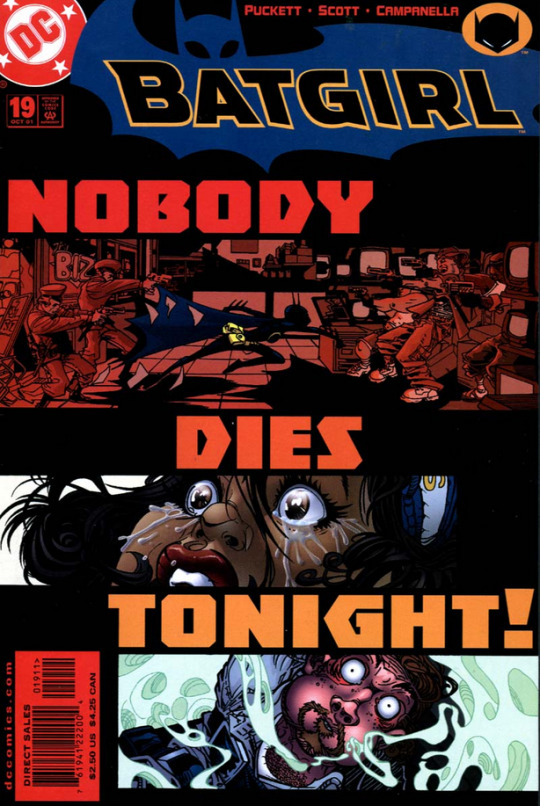
Batgirl (2000) #19 - October 2001 Writer: Kelley Puckett..........Pencils: Damion Scott Inks: Robert Campanella.....Colors: Jason Wright
Another memorable one shot story in what has become the definitive Cass Cain story mold. I don't think I'll have too much to say about this issue specifically. Those who were fans back in the day surely remember it, and if you're new to Cass's Batgirl run then as always for this early period it's a good book and I encourage you to go out and read the issue for yourself, especially since work has been busy this week, so I don't really have time to go through this issue in detail.
Still, by way of brief recap, this is the one where Cass is patrolling extra hard, determined that literally nobody in Gotham should die that night, when she's distracted by a news broadcast:

Wait, whatever state Gotham is in has the death penalty? Then why do all the super criminals never yadda yadda cinema sins ding sound.

The guy himself is super stoic about it. No sign of repentance or reflection or regret, but he's clearly accepted what's about to happen and determined to face it with some degree of dignity.
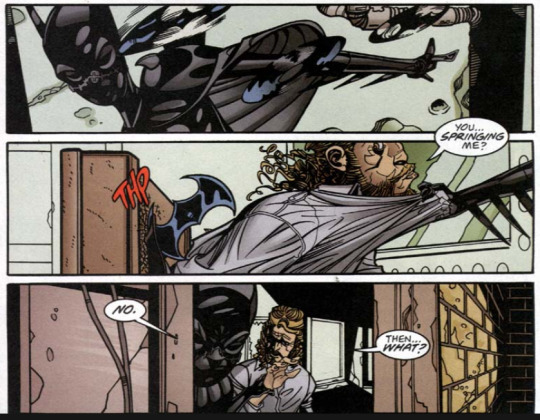
But then cast abducts him mid-execution
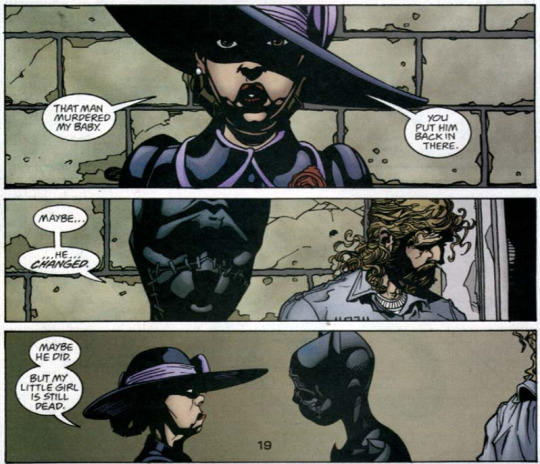
Only to be stopped by the mother of the woman he killed. I know I'm rushing through this summary, but just, the faces in these panels are so good. Cass's pleading and heartbreak, the woman's implacable stone-faced determination in the face of this demon-looking vigilante, the way the murderer, shocked out of his stoicism, can't bring himself to face this woman. Also just thematically, the metaphor here for Cass's own internal struggle with guilt, that no matter how much she's changed, no matter how much good she does as Batgirl, the man she killed, someone's son, maybe someone's father, is still dead, and she can never change that. It's extremely blunt and on the nose, but it works.
So anyway, back the murderer goes, only now that his stoic shell has broken he can no longer face his end with peaceful dignity. All Cass managed to achieve was to make his death more horrific.
And of course we find out that the reason Cass was so determined that nobody should die is that this was the anniversary of the murder she committed. Which of course is a very Bruce-like sort of sentimentality.
....
We've seen this sort of stand alone episodic one shot from Cass several times now. As much as I like the more serialized stuff playing with her various relationships to Bruce, Babs, the rest of the Bat family, or her dad, or her mom (as of yet unconfirmed by canon), these sorts of one shots really do seem to be the stories og Cass worked best in, the stories she was designed for even. While we've talked about this before, here a short bullet-point review of what defines a classic 'Cass Cain story' from her early Batgirl period
Stand alone story. One issue of the comic, one complete story. It might presume familiarity with Cass's character and background, but they're generally meant to be satisfying even if this is your first introduction to Cass.
Human focus. Cass's stories are concerned not with aliens and demigods and magic and science so fictional it might as well be magic and other larger-than-life comic book tropes, rather they're focused on relatable human characters, regular people trying to survive in a dispassionate world.
Somber tone. Cass's stories aren't upbeat action adventures where good triumphs over evil. The overall tone isn't fun, it's sorrow, grief, isolation, where light and hope are all the more precious for how rare and fragile they are.
'Street level' antagonists / no costumed criminals. This is arguably necessary to maintain the above focus and tone, but no super villains whose bombastic gimmicks and personalities would distract from the humanity of the everyday people around them. Even in the rare case when an enemy has super powers - "Meta" in issue 3, Kenny in issue 10, the cybernetic assassin in issue 18 - they're still dressed in more or less normal clothes and treated as regular people, not comic book super villains. And even then they're the minority of antagonists, usually Cass is fighting regular street thugs and mob guys, even though she's arguably the most explicitly superpowered member of the bat family, which in turn minimizes the length and importance of action scenes so the story can focus on human drama and personal themes.
Heavy thematic resonance. Cass as a character is about family - the family we're born to, or that we choose, and about the tension that results when a family member genuinely loves you and yet is still terrible for you or to you. And she's a character about doing the right thing even when it's hard, even when it doesn't seem to make anything better. And she's a character about guilt, about what it does to you, about how it can motivate you to do better while still hollowing you out inside, about how penance alone without the catharsis of absolution is a bottomless pit that will never be filled no matter how many acts of contrition you pour into it. These themes are the core of Cass's character, and her most iconic stories all relate back to one or more of these core theme in some way. "My dad's bad, isn't he" "Maybe he did [change], but my daughter is still dead"
Not every issue of Cass's book has fit into this description, but when she's not caught up in some crossover story or going through some significant shift to her status quo, these are the sorts of stories she's engaging with on a regular basis. Again, these are arguably the stories she works best in.
I've made no secret of the fact that, while I like modern Cass and I'm glad she exists, she doesn't really hit the same to me as Cass classic. And yeah, a big part of that is that her history and relationships just aren't the same. She doesn't have the same fraught relationship with her father, there are no parallels between David and Bruce, Bruce isn't particularly central to how she became a hero - he wasn't even Batman at the time. She didn't become a hero by stepping into a legacy role Babs had left behind, so there wasn't this close generational connection between her and Babs, or even any particular relationship between them at all until a good deal later.
She still felt guilty over killing someone, but it was something she was forced to do under threat, not something she willingly did only to suddenly regret it in the aftermath, so the guilt seems a lot more misplaced. Also everyone knew about it from pretty early on and forgives her for it, there isn't the same period of her actively hiding it sure that everyone would reject her if they found out like we talked about last time.
So yeah, so, so much of her history and relationships are completely different, but something I maybe haven't focused on enough is that her stories are different.
From the moment modern Cass is introduced she's tied up in global conspiracies, the league of assassins, people turning into monsters. She's on teams with super-powered allies fighting costumed super-criminals in serialized stories that take years to play out to any meaningful resolution. The concise, street-level stories focused on the individual humanity of the people involved and on connecting her stories to her history by thematic links... I haven't read all of modern Cassandra's appearances, but I've read enough of them to say that these kinds of stories either simply aren't present or are overwhelmingly in the minority.
Even in the 'Batgirls' title that sadly ended last year, with Cass, Steph, and Babs are working and living together, theoretically my all time dream book. But their interpersonal relationships are rarely the focus and their adventures are mostly fighting various larger than life costumed criminals. It was a fun book, sure, but even in itself that's a break from OG Cass's deliberately somber tone.
So I guess if there was one thing I'd like to see from modern Cass, apart from some sort of retcon restoring the OG David Cain with his difficult and layered relationship to Cass, it would be a return of the archetypical Cass story, because these are the stories that best highlight Cass's best qualities - her empathy, her compassion, her inner conflicts.
23 notes
·
View notes
Note
Apologies for the extremely long ask.
Omegaverse as a concept is so complicated and interesting as to me as a trans person.
On the one hand, the writer in me is intrigued by the world building implications and the opportunity to explore gender roles/dynamics. The concept of having a secondary dynamic alongside your actual gender is also fascinating to me and it's something I typically would have expected to be in something like sci-fi before I actually got into fanfiction.
I especially love deep diving into pack dynamics. Admittedly, that's where most of my interest and attention is focused on when reading and writing Omegaverse. I just find the concept so fascinating and any opportunity to write characters with heightened instincts, alien or otherwise, is just so much fun.
But on the other hand, I'm also very aware of how Omegaverse came about because some Supernatural fans wanted to play around with the idea of pack roles/relationships based on a messy study of wolf hierarchies. I'm also aware that intentional or not, a lot of early Omegaverse fics and tropes leaned really heavy into more homophobic and transphobic stereotypes, especially between M/M pairings.
I do feel like this has changed a bit over the years, though. From what I recall, a lot of early Omegaverse fics just really over relied on the stereotypical "which guy is really the girl?" trope that you saw a lot in the early to mid 2000s when discussions of queer (but mostly gay) relationships were brought up. I feel like the discussion has become a lot more nuanced since then and I know there are other trans fic writers like me who enjoy writing Omegaverse simply because it provides an opportunity to explore concepts of gender, sexuality and identity in a relatively fun way.
Not all Omegaverse fics/tropes are created equal, though. And every trans person has a different reaction/feeling towards this AU. I definitely feel like the odd one out, though, sometimes since I mostly come to Omegaverse for pack dynamics, less so for the smut (although I have written some in the past for fun or for friends). But I also believe there's validity in writing smut just for the purpose of enjoying smut.
Overall, I think this AU has a lot of potential, but I also see why it could make people very comfortable. I do wanna say that your fics haven't made uncomfortable and I do enjoy your takes on this trope. And I especially appreciate your willingness to listen to other trans people and their thoughts on Omegaverse. It goes a long way.
Side tangent: I will always be amused by how this whole trope came about btw, but also because the original author of that study followed it up by saying his first paper was absolute bullshit actually and shouldn't be viewed as a factual study of wolf pack hierarchy. Man messed up his original study, but he's a dedicated scientist and I love him for debunking his own work. But also the fact that he had an unintended impact on fandom is such fucking gold to me. I love this man so much.
Thank you for putting my thoughts to words, anon! There's definitely a long history there, and I agree with you that the genre itself has changed a lot in recent years, I think for the better.
I don't begrudge anyone for not liking or wanting to read a/b/o fics at all. I think it's intriguing but has the potential to be deeply uncomfortable or even like you said, transphobic for some people. I try to tag everything very well here that mentions it, etc.
I think what I like most about recent changes is that the genre has shifted to be less about "how can we get these two characters to breed?" and more to discussing pack dynamics, the implications of designations and gender roles, and building interesting biological rules and intricacies in an author-unique universe.
#asks#anon#thank you for sharing anon!#a/b/o mention#a/b/o tw#myfic#theresurrectionist#a sky of honey
31 notes
·
View notes
Text
Posting A Few More W's
Oh hey folks! The site's not dead at all, don't worry. It's just that I have accumulated so many GB cartridges now that my current decorated storage boxes are full- and I'm still in the process of painting a new one to start hoarding more. Mine's an organized collection, mind you U_U
Nevertheless I've been playing a lot elsewhere, mainly on the Switch because I realized I have one at home I mean, its library of graphic adventures has plenty of interesting titles, but also on several other consoles as me and my brother currently have a knack for platforming adventures. We're especially looking at some 3d explore-and-collect titles released during the early 2000s on consoles we never had the occasion to try at the time: GameCube, PS2, the original Xbox. I feel like this was a generation I completely missed, as when Nintendo's cube came out I could only read about it on magazines while I played my GBA (still very loved of course!) and its Sony and Microsoft rivals were pretty much unreachable for me (I doubt I was even aware of the Xbox's existence at the time, incredibly).
Anyway, wanna know what's the best thing about these 3D platformers? They all have a screen displaying your progress and all available collectibles, something that pushes players to go for a 100% complete run (which is one of the things I love the most about games- pretty sure the Pokèdex started this obsession of mine) and that's very easy to take a snapshot of, in order to show off the completed mission. So here's a gallery of our completed games! This is a spiritual sequel to my post about personal gaming achievements, as I feel seeing these screens is an achievement of its own.
Vexx
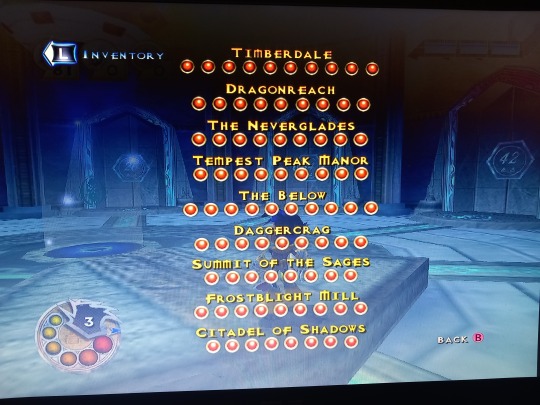
Vexx is a game with a very odd charm to it. My brother hates it and I partly agree with his distaste: it's flawed, oftentimes buggy, most of the difficulty is due to its unpolished controls. However I feel it also oozes with style, tries to paint a bigger picture than what's shown ingame and it's clear there was a special passion put into it, the developer team wanted to impress. I like the edgy protagonist and his design; I remember looking at a few dedicated advertisements and being very curious about it. Nevertheless, I admit taking this game to full completion was quite a pain! I'm proud of this screencap.
Super Mario Sunshine

This title is a white whale for many players, since like half of the planet forgot the GameCube existed and now it racks up thousands on the secondhand market. I've always wanted to play Sunshine, it's the only 3D Mario chapter I was still missing and the reason why I was so very tempted to get 3D All Stars, yet I knew the Switch's emulation of the Cube was subpar. So we emulated it elsewhere. :V This game is so short! Everyone treats it like a gem and the general hype and mystique surrounding it might have elevated my expectations too much. Nevertheless we had fun, but less than what reviews promised us and if we have to choose, we'd still go for Galaxy over this.
The Incredible Machine

Oops, here's the odd one out of the list. :P Me and TIM go way back, I already talked about this game in one of my earliest story posts and it still bears an important heritage in my childhood; however, I could never finish it back in the day! The later puzzles were too complex for kid me and my english was still extremely unripe to understand what I had to do in the stages. Seeing this screen would make younger me very proud!
Ty The Tasmanian Tiger
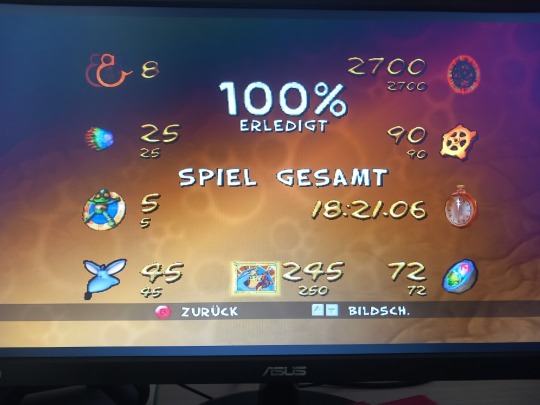
If there was a class for mid 2000s abrasive platform mascots, Ty would have graduated with pomp and circumstance. This game follows every aspect of that trope to a… Ty. Antropomorphism, unusual species, comparative and aggressive advertising, catchphrases, characters trying to crack jokes every single time, an evil clone, the bad guy using robotics for end level bosses, big levels with lots of secret areas and tons of collectibles. Granted, not everything listed here is a bad thing: I appreciated the representation of australian fauna and enviroinments, also big levels and many collectibles were exactly what we were looking for when me and my brother started scouting for games to play. But there's also a huge level of unpolishness to it, like we played a beta of the game: it got too easy too fast with one of the boomerang powerups being an infinite machine gun and the other a literal nuke who automatically eliminated enemies (not that they were a threat before- we never got a game over); other boomerangs were barely employed in puzzles and game mechanics; transitions were nonexistent making cutscenes and level warps end abruptly; the sound design was especially lacking; the fire particles were absurd and we couldn't understand where it began and where it ended; similarly, the lacking shading on many platforms made jumps difficult. We got into a disagreement because I feel like this game should rank worse than Vexx while my brother swears it's Vexx still being inferior to this. We can't come to a conclusion on that. Anyway, this is as far as we can manage to go with Ty; the game is 100% complete with all collectibles except, sigh, five concept art collectibles out of 250. We literally combed all levels three times for them and like Dark Helmet's subordinates we ain't found shit. Also 250 concept art pieces? It really shows the game didn't fill up even a quarter of the disk (we were impressed on how short it was). If you're wondering why the screen's in german, my brother got quickly tired of the australian voice accent and wanted to hear all the other dubs. XD Are we gonna play the sequels? Fuck no!
I may get back to this post for the rest of the summer if we manage to take a picture of another completed collectathon! Otherwise, I'll make another in the future!
0 notes
Text
The Twilight Saga: Twilight (2008)
Starring: Kristen Stewart, Robert Pattinson, Taylor Lautner, Nikki Reed, Ashley Greene, Kellan Lutz, Jackson Rathbone, Peter Facinelli, Anna Kendrick, Elizabeth Reaser, Billie Burke, Christian Serratos, Rachelle Lefevre
Screenplay by Melissa Rosenberg
Directed by Catherine Hardwicke
I do not own any of the pictures posted.
SPOILERS AHEAD
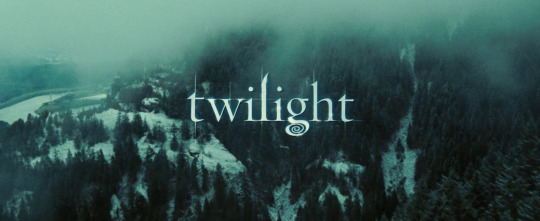
First of all, you have no idea how excited I am to finally be reviewing this. (I have popcorn!)
Twilight may perhaps be one of the most recognizable films of the early 2000s vampire craze. Now, whenever someone mentions the word Vampire I immediately think of Twilight. (Also The Vampire Diaries, but that’s a story for another day.)
Twilight follows seventeen-year-old outcast Isabella “Bella” Swan, after her relocation to Forks, Washington, from Phoenix, Arizona to live with her father, Charlie. Charlie is the towns’ police chief, while her mother, Renee, is married to a minor league baseball player named Phil.
After the move, Bella becomes reunited with childhood friend Jacob Black, a Native American teenager living with his father, Billy on the Quileute Indian Reservation near Forks. Bella soon makes friends at her high school but is drawn to the aloof and quiet Cullen siblings consisting of Alice, Jasper, Rosalie, Emmett, and the famous Edward Cullen. She is seated next to Edward in biology, to which he acts almost repulsed by her. After the Cullens are absent from school for a week, Edward returns to class and socializes with Bella. A couple of days later, an out of control driver nearly crashes Bella in the school parking lot, but Edward instantly covers a distance by thirty or so feet in order to prevent the van from striking her. After arriving at the hospital, Edward refuses to explain his actions to Bella, ultimately warning her against being friends with him. Jacob then informs Bella of the long-standing rivalry between the Cullens and the Quileutes and that the Cullen family is not allowed on the reservation.
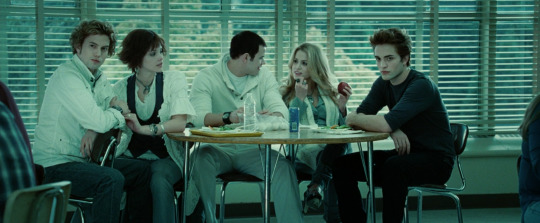
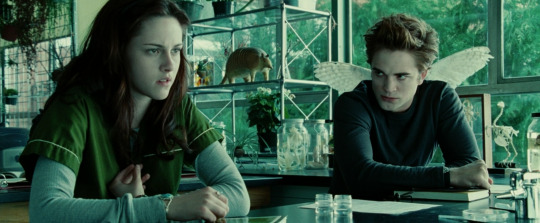
Bella then begins to research Edward’s condition, ultimately concluding that he is a vampire. He confirms this but pleads with Bella that he and his family only consume animal blood. They soon fall in love, and Edward introduces Bella to his family, where she meets Carlisle, the family father, and a doctor at Forks Hospital, Esme, the family mother, and their formally adopted children Alice, Jasper, Rosalie, and Emmett. The family’s reaction to Bella is generally positive except for Rosalie’s, who fears that her family’s secret can now be exposed.
Bella and Edward’s relationship is soon jeopardized when James, Victoria, and Laurent, three nomadic vampires arrive in Forks territory. They are responsible for a series of attacks leading up to and in the Forks territory. James, who’s described as a tracker vampire with incredible hunting instincts, is consumed by Bella’s scent and becomes obsessed with hunting her. Edward and the other Cullens protect Bella, but James ultimately tracks her to Phoenix, Arizona, where she’s hiding with Jasper and Alice. James lures Bella into her old ballet studio as a trap, attacking Bella and infecting her with vampire venom. Edward arrives and fights James, subduing him until the other Cullens arrive. Alice, Jasper, and Emmett kill James, decapitating and burning him.
In the aftermath, Bella suffered a broken leg and is hospitalized. Edward accepts Bella’s invitation to their high school prom, where he refuses her request to turn her into a vampire. They are unaware that Victoria, James’ lover, is secretly watching them, in schemes to avenge his death.
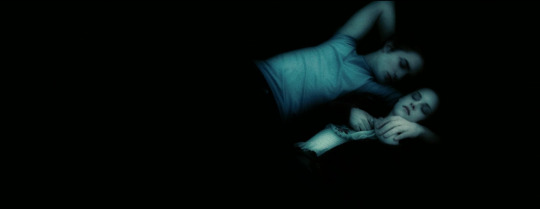
Let’s talk about Twilight as a cultural phenomenon. It pleased devoted fans to the novel series, while also defining an early generation of the vampire-romance genre. I was five when the first Twilight movie was released, so it was never a huge part of my life growing up. However, I do remember the cultural aspect of the films. I remember going to the mall in the mid-2000s and seeing posters and pictures for it everywhere. Twilight, like it or not, was everywhere from 2008 to 2012 and has experienced a surge in popularity since Stephanie Myer’s release of Midnight Sun, which is Twilight told from Edward’s perspective.
If you couldn’t already tell, I’m a huge fan of Hardwicke’s directing style. I think if she continues to direct the following Twilight films, New Moon, Eclipse, and Breaking Dawn 1 & 2. I would have enjoyed the later movies as much if not more if I enjoyed the first one. However, that’s not to say that I don’t enjoy the series as a whole. I think it truly defined the early-mid 2000s, and the nostalgia of the movie I think is more remembered than the actual story.
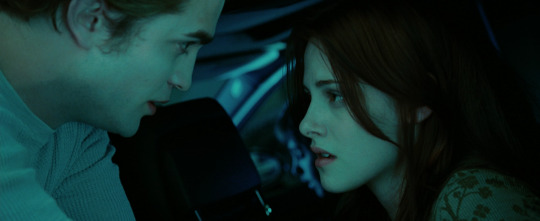
My friends and I still have Twilight marathons to this day. Do I think it’s deep? No. It’s about a girl falling in love with a 108-year-old vampire, of course, it’s not deep. Plus, the film, novels, and the story are directed at teenage girls, who of course back then, couldn’t possibly understand the complexity of a well-written and well-developed script. Do films have to be deep in order to enjoy them? No, absolutely not. I think that most of the people who heavily critique Twilight think that it needs to be deep in order to be enjoyable. Twilight, in no shape or form, I think claims to be deep. I think it’s a cultural phenomenon, and because of that, people think it has to be the next generation-defying film that has to be good. I also think that it’s more popular to hate Twilight because it's directed toward teenage girls, and, as we’ve learned, teenage girls can’t have anything without being made fun of.
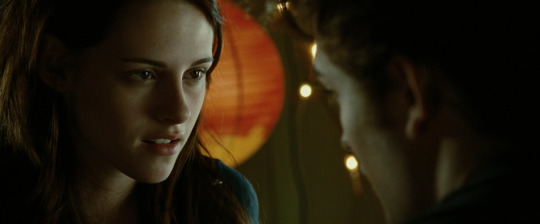
I also want to talk about Bella’s plainness. When I see critiques on Twilight or Bella’s character in general, said critiques typically argue that Bella’s lack of personality in the films (and book) is a major turn-off. I agree that she’s plain, but I don’t agree that she’s a major turn off when it comes to my love for Twilight and the saga as a whole. Truthfully, she was designed to be a plain and somewhat modest teenage girl. Everyone around her, especially her friends, are full of life, while she is frankly dull. She is one of those characters that is written to coincide with another, that being Edward Cullen.
In my perspective, they are two sides of the same coin. For example, Bella believes that she has nothing to live for, while Edward is pushing and pushing her to live and have the life he never got to live. Bella is extremely realistic for a teenage girl, honestly. Her “normal” attributes make Edward seem more desirable and God-like. I think it's time we stop picking on the “boringness” of characters written for and about teenage girls, mostly because I think it's just another thing that young girls can be put in a box for. If they’re not interesting or captivating enough for a certain audience, they’re plain and dull and lifeless. If they’re too interesting or captivating, there’s always something wrong with them (hence the manic pixie dream girl trope). Bella, I believe is written against that trope, and that is why she’s boring.
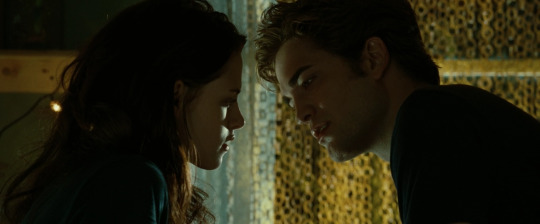
I enjoy Twilight. I do. And I’m not ashamed of it. I don’t think every movie has to be life-changing to be defined as a cultural phenomenon, or even enjoyable. I think when people say that Twilight is “bad” we have to ask ourselves what a “bad” movie is. “Bad” and “good” is completely subjective to who is watching it. As a teenage girl in my life right now, I enjoy watching Twilight. Truth be told, I like the story, and I like the nostalgia attached to it.
I wonder if my feelings would be different if I was a teenage girl in 2008 when the Twilight film was first released. I wonder if I would hate it because I was told to hate it, or if I would like it because it’s something that I enjoy. Nonetheless, the first Twilight film will always have a special place in my nostalgic little teenage girl heart, everything from Bella’s bleak green and purple bedroom to the clearness of the Cullen's barely used kitchen.
Overall rating: 9/10 (For the nostalgia, of course.)
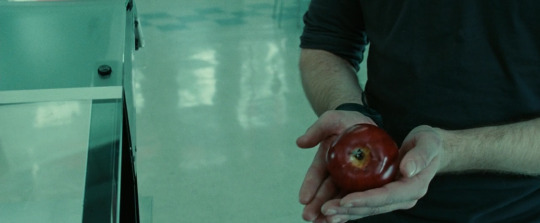
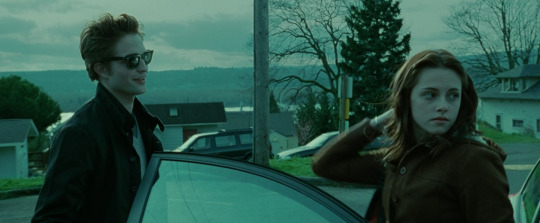
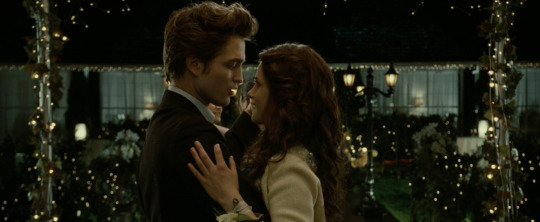
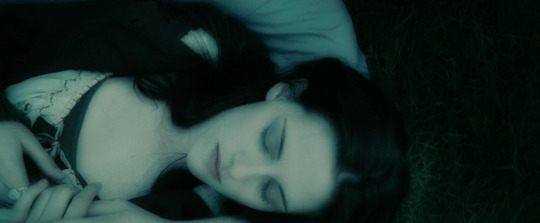
#twilight#thetwilightsaga#stephanie myer#catherine hardwicke#bella swan#edward cullen#alice cullen#jasper cullen#rosalie cullen#emmett cullen#kirsten stewart#robert pattinson#2000s movies#2000s core#2000s nostalgia#2000s web#2000s#2000s aesthetic#2000s films#filmreview#film#vampire#moviereview#movies#americanmovies#female directed movies#female film directors#female filmmakers#novel#twilight books
22 notes
·
View notes
Text
15 yr olds on this site really go around totally unsuspicious of fictional media discussing gayness or including gay characters huh
idk about you but i was born in 2000 and my entire life i dealt with blatantly homophobic media (power puff girls is one example!) and intense queerbaiting coupled with homophobic plotlines (supernatural, the 100). i had to ferret around the internet desperately to find a shitty copy of a somewhat decent film involving gayness that wasnt something like philadelphia or debs or rocky horror. when i was struggling the most with coming to terms with my bisexuality was around the period of 2010-2015. during that time antibisexual sentiment was incredibly high (this was when the post-myspace backlash of bisexuality and the rise of mogai and pansexuality came about). every time a tv character was announced to be gay (extremely rarely) they were killed off or forced into homophobic plotlines and stereotypes within episodes. they were the butt of jokes, fandom and the world made fun of them to hell. our expectations for gay representation were extremely low, to the point that we were happy with the kill your gays trope because at least we got screentime.
korrasami was the breaking point of all this. since then, the media has been much more inclusive and receptive to actual gay criticism and queer theory (as flawed as it is). a children’s show with a massive fanbase made their two female protagonists of colour bisexual and in a romantic relationship. this was huge. this is the best gay representation to date in children’s media. the backlash was still huge, and even more chose to ignore it and pretend it wasnt canon, despite the creators and writers specifying in interviews almost immediately that it was, and that nickelodeon had in fact forced them to cut a kiss scene.
but nothing has really changed. even if there is slightly more gay representation, even though our criticisms are now part of the public conscience, what has changed in western media really? gay representation is white and middle class and vague. it’s liberal, it never depicts any form of the community that is so important to gay film as an establishment, never depicts proper homophobia. it is safe and consumable for homophobes. it’s straight gayness. films such as love, simon and call me by my name depict sanitised, and even homophobic depictions of gayness. it’s hollywood gayness.
queerbaiting still exists - for example, the voltron reboot frequently hinted at lance’s bisexuality and keith’s gayness, constantly foreshadowing a romantic relationship (and yes, there is proof for this. analysing the show and looking at interviews from the time, as well as looking at the complaints about the showrunners from the writing staff in particular who specified that they did not allow the writers to plan a plot and anything that had the potential of upsetting their ratings and upstanding with dreamworks higher-ups were quickly cut - this makes it clear that something was going on there), constantly talking about it with fans, only to have this foreshadowing, the various promises to the community, fall away. shiro was revealed to be gay, a teaser trailer showed him with his boyfriend. in the actual series, the boyfriend got less than a minute of screentime and was killed immediately. shiro, an asian gay man, was made into torture porn. this is queerbaiting and a homophobic trope as well.
ive seen this with innumerous shows as well. gay characters are introduced as a grab for a larger audience and free advertising via people discussing the show on the internet.
so yes. on the surface, it seems that things have changed. younger people are being told that gay media is the norm, that we are living in good times, and they are being taught queer theory criticism of media via a hollywood and social media lens.
but beneath? nothing has changed. i still get twinges of fear when hollywood and netflix try to appeal to gay audiences. i still dont trust the representation they provide. i am still ferreting about the internet to find a copy of an independent film. i am still watching the same four gay films.
it sounds strange when i say that i hate gay representation. but this is what i am referring to - hollywood representation, netflix representation.
i have seen a strange gap in ages and response to gay representation in hollywood and netflix productions. young people who were born after about 2003/04 are the current main targets of most hollywood gay representation. korrasami became canon when they were just 10 years old. this cultural shift happened before they were old enough to truly realise what was happening. and with no one discussing just how big that cultural shift was and has been, there is no consideration for their own past that can take place within their own thoughts. it is normal for a tv show to have a gay character and so long as that character isnt killed off they’re happy. ive seen this sad trend of young teenagers consuming characters and representations of sexuality like this with total happiness. even some of the smartest, most media-critical kids ive ever met still engaged with love,simon with complete and utter praise.
but to those born before, we grew up with something different. shows like the powerpuff girls had transphobic depictions. gayness was reserved for adult, latenight shows like the l-word. homophobic and transphobic punchlines were the norm. lesbian was ugly or a porn category. bisexual was unheard of - our flag was only designed in the very late 1990s. or we were whores. for a moment in the mid-2000s we were celebrated in teenage underground movements such as scene, punk, emo, etc. but by the early 2010s we were being named as affronts to the lgbt community (once again). transgenderness was completely reviled (still is). we were queerbaited and slandered and hated by hollywood
ten years later we are said to be “welcomed” in media. but i feel no difference. i am still suspicious and bitter and disappointed and disgusted. i dont feel welcomed nor celebrated. i still feel disgusted with myself and i still feel hollow and hated - because i am. we are. hollywood is not your friend. it never has been. representation is a cash grab.
3 notes
·
View notes
Text
Billy Hatcher and the Giant Egg Review Script
*To be edited and slightly trimmed down*
*Will be very different after voice-over, video, and final cuts are made*
When I was growing up in the early 2000s I rarely had any exposure to many big game mascot franchises. The only ones I had seen were Mario 64 and pokemon at my cousin’s house or my sonic 3 & Knuckles CD for our family computer that used keyboard controls. And there’s no way in hell my tiny little hands would be able to reach any sort of playability on that PS/2 port windows XP nightmare dinosaur. Nooo, the only thing I really played as a kid was Spyro the Dragon on the playstation 1.
If you’re old enough to remember anything before the Nintendo Wii, then you probably remember going down to your local walmart or target and trying the demos for the latest video games.
You know,
looking directly up,
at a 90-degree angle,
with an impossibly short cable,
trying to play a children’s game. (echo in the background: WHY? LIKE WHAT THE FU-” *cut to next clip.*
Now I’m sure it sounds like I’m just rambling, and don’t worry I’ll get to that point, but I wanted to share my magical 2003 experience with one of my favorite games. The gamecube demo had a special disc on it. This magical little disc had several games and trailers to distract kids and fathers while mom goes and picks out some socks for tomorrow's Sunday Mass. For the older crowd, this preview disc had games like Tom Clancy’s Splinter Cell, Soul Calibur 2, and Viewtiful Joe. While the kids they had Sonic Adventure DX and Billy Hatcher and the Giant Egg. Of course, I chose the Boy who Hatched: Billy. Hey, I was a little kid, I saw colors, a silly name, and a chicken suit. What more could peak my interest?
So I gave it a try. And I died. I died a lot. The demo starts by having you roll down a curvy path to the beach. I constantly fell into the water. I don’t even remember how far I got before I had to stop. As mom called me away, I felt a mix of disappointment and longing for more on top of my terrible neck pain.
And so I forgot about Billy and his Egg rolling adventures for the next few years. By then I had my own Gamecube and several games for it like Mario Sunshine, Sonic Heroes, and Pokemon Colosseum. Every time dad and I would go to our local gamestop, I would poke through the games and see if I could find anything. Dad would try to speed me along by suggesting a game, and I usually would have turned down whatever he chose. Until one day he grabbed billy hatcher, not because it was at a wicked good price or that he knew I would love it. He just was getting my attention with it because he liked to call me a chicken as a kid and he knew it would rile me up.
So of course, I bought it and took it home with me. First thing that got my attention was that it supported multiplayer. As the older brother I was naturally used to thrashing my younger sisters in mario party, so what was another game to feed my dominance as the eldest child? My sisters and I loved it.
We rolled around on eggs,
collecting fruit,
hatching the eggs,
collecting animals,
attacking each other with the animals after spending an hour on one round
Basically Ark: Survival Evol-*T-Rex Roaring clip*
We had names for a few of them too. We knew some of their names from the manual, but we called this one Chelk, Bunnybird, Lion, Sharky, Ostrich… We weren’t very creative children.
I guess the point I’m trying to convey is what this game was for me and my siblings and how much we enjoyed it. I was never able to get super far in the main game cause I was a kid and I sucked at video games that weren’t Spyro the Dragon or Pokemon Ruby.
So what was the reason for that build up? Why did I ramble about quality family time with a video game about kids rolling around eggs? I don’t know. I don’t have a direct focus for this video. But I would like to talk about what I think of the billy hatcher game now that I’m an adult.
So Billy Hatcher and the Giant Egg… How do I begin this? You’re a young blonde boy Billy who’s overslept for his outing with his friends. He and his friends see a small chick that is being attacked by a crow, so Billy beats the fuck outta it with a stick. It is then revealed that the chick is actually the Chicken God of MorningLand. Billy and his friends are then taken to the new world to be the chosen heroes. I guess this is a new approach to the Isekai genre, so move over SAO and No Game No Life Billy’s coming to take over.
After donning the hero’s rooster outfit, Billy Hatcher and his friends Rolly Roll, Chick Poacher, and Bantam Scrambled set off to free MorningLand from the evil crows.
Each level until the final boss is structured in the same method. With a few varied level challenges moved around. You arrive in the new level with a hearty “Let’s Go!” and set off to find the trapped chicken elders, roll them over fruit, and then hatch them to obtain this game’s power star; an emblem of courage. The next level will always be a boss fight. This is what I’d usually consider what a developer would have put into place in order to keep the game kid friendly. Like allow a child to do what they’re able to do and then beat the game for their own success. While the older crowd can appreciate value in getting all of the mcguffins and beating all of the challenges. But that didn’t really happen. You see. There’s only about 6 levels. You need about 20 or so emblems to enter the final level. So if you try to move onto the final level, the game will spit you back to the stage select after you’ve trudged your way through the sand stage until you have 20 emblems. Therefore, since you only have about 12 emblems, you’ll need to go through the stages to pick some levels. Now the structure for the other stages follows a mismatched order of this for a total of 8 emblems for each stage: collect X amount of giant coins, kill 100 crows, race an NPC, find and free the 7 caged chickens, and 1 or 2 actually creative levels for that stage. 3 of the stages have you save your captured friends before they’re blown up for it’s level 4. Then allows you to play as your friends. I always liked playing Bantam as a kid cause I thought he could grab ledges better.
Stages also follow the Sonic stage tropes we all know; Forest, Pirate, Volcano, Ice, Circus, Desert, and Chicken Heaven...
Once you reach the final level you dont need to free any chicken elders, you just travel to the final boss. And I’m sorry if this is your favorite childhood game, but this final boss is terrible. And it hurts any sort of story conclusion the game was trying to have. Your final boss is I believe named Dark Raven. You use a mechanic they taught you earlier in the level in order to beat his first form. You must roll over a dark patch on the ground until it is completely gone. You dont need to get all of the circles cleared, just the one. And believe me, you’re gonna have a hard time with this. The game wants the whole circle gone with not a single pixel left otherwise the circle reforms and damages you. This becomes incredibly frustrating when there are more circles placed down and you can’t tell which circle had which darkness. This is all going on while this snarky asshole raven watches you aimlessly roll around in front of him. His final form is just another giant raven, but “spookier” I guess? At first you can’t really do anything to him and the bird just rips off your chicken suit. But then Chicken God steps in and gives you some good ol’ divine intervention with a new chicken suit. But this one has a fancy light effect thing going on. Anyways now you must dodge the raven attacks and wait for the most damning mechanic of all to screw you over. You need to stand in the direction of the raven. Wait for it to fire a ball of light at you, press the B button at the perfect frame to catch it, and then beat the fuck outta it to finish him off. I died so many times to this thing just because I missed the perfect frame grab. You have zero room for error on this one.
After you save morning land the whole chicken world sings your praise and peace returns. But now we can talk about the interesting part of the game; the gameplay mechanics. Once billy has an egg his mobility is staggering.
You can press A to jump
Tap A again to bounce jump off the ground
hold A for a ground slam
press B to smash the egg down in front of you,
Hit R in mid air to do an air dash in the direction of your choosing
Press B on the ground to roll your egg forward and watch it boomerang back to you
Press R to accelerate yourself for an egg dash
Press A while you’re dashing for a long jump to fling yourself super far
These abilities can be super well executed with the stage design allowing you to travel extremely fast and perform nifty combos.
Each stage is littered with eggs of all kinds. They either have an animal inside to help you, or a power up. You don’t need them for about 95% of the game. They’re pretty useless. You just need to use your egg to kill things. And you only need the animals for 5% just to solve a few level gimmicks or wall blockings. The power ups are pretty pointless outside of multiplayer. Sorry if that cracks your egg.
But I still love the jester hat, please don't hate me.
Each level has 5 chick coins for each stage. These are a neat thing to hunt for, but are ultimately pointless. They allow you to use that level’s sonic egg that would have been normally unobtainable. These eggs hatch into none other than big name Sega characters. These are also pointless. They’re just the normal animal powers copy/pasted onto sonic, Nights, Chu chu rocket, and PSO character models. They’re a neat thing to see when they appear in multiplayer, but they’re no more helpful than other eggs.
Which brings me into the best aspect of the game; the multiplayer. You and your friends can play in either a death match with stock or just hatch animals. However, the animal hatching only goes to a pre-set amount of points. Which you can just steal and win instantly by killing your friends. Kinda just turns into another just deathmatch. And when the screen is all cluttered from splitscreen, it feels difficult to control the camera properly. Why do I like this gamemode again? Oh yeah, nostalgia…
Scattered throughout each boss level is a special egg that allows you to demo a small downloadable game. When you connect your GBA via a cable to your Gamecube you can play several games. Easy and Hard Chicken Shoot, NiGHTS, Chu Chu Rocket, and Puyo Puyo Pop.
Chicken shoot is bad, its just a terrible top down game where billy must roll an egg over some crows. Hard isn’t hard at all. NiGHTS is entertaining, I have no experience with the games yet, but I probably should give them a shot. I can’t do chu chu rocket since I’m a little slow, but my sister is surprisingly good at the game. But puyo puyo pop was great. Lining up colored dots to clear the screen against another player is very satisfying. It reminds me of pokemon puzzle league for the Nintendo 64. I probably should get the new game for the switch…
*GBA SP joke clip*
Last thing I want to discuss is why I think this game might have been so important for Sega when it came out. It was the first full game and original IP developed by Sonic Team for another system that wasn’t a port of a previous release. Sure they probably wrote “from the creator of sonic the hedgehog” on the cover just to push sales, but Yuji Naka’s name might not work as well as it did 10 years ago. His latest title was Rodea the Sky Soldier for the Wii & Wii U which I think deserves its own video at some point. This game was exclusively available on the Gamecube while Sonic Heroes, which released a few months later, was multiplatform. And hell, I’d rather play this game than Sonic heroes any day. And the reason why is so important, is because it was during the era 2 years after the dreamcast was discontinued and Sega went permanently 3rd party. I don’t want to talk your ear off about the 90s and the “console wars”, you’ve heard that all a thousand times before. But since then, Sega has created a variety of games that are only possible because of this relationship they’ve obtained with nintendo. Fans finally got the mario and Sonic olympic games series, and while I’m not remotely interested in them they must be doing well if they keep publishing them. But we also got Sonic colors in 2009, which is a fantastic game. And while some of the sonic games on the wii U were… lackluster, Nintendo paid for the development of Bayonetta 2 from Platinum for the Wii U. A series that sega had zero interest in funding. I could keep rambling on about them even slapping in the the gba demo download functionality, Sonic getting put into smash bros, or whatever nonsense I could come up with. But I just wanted to lament about one of my favorite childhood characters.
So that’s what I think of Billy Hatcher and the Giant Egg. A lovable young boy with the ability to roll eggs. Sure, the game is littered with issues and I might only like it because of nostalgia. But I think it’s an amazing platformer nonetheless. Give it a try if you ever get the chance. I’d like to hope for a sequel, but the game’s poor sales have probably doomed any chance of that ever happening. But if you ever want to play as the boy who hatched in another game, he’s playable and makes cameos in Sega Superstars, Sonic and Sega All stars racing and racing transformed, Sonic Riders and Sonic Riders Zero gravity.
#saffron#review#script#Billy Hatcher and the Giant Egg#SEGA#Sonic Team#Gamecube#Nintendo#Controller#2003#Dreamcast#Sonic#Yuji Naka#Rolly#Chicken#Morningland#Demo#YouTube
0 notes
Text
17 Indie Superheroes Who Need Movies NOW!
While most superhero movies are based on characters from Marvel Comics or DC Comics, a handful of other characters have made their way to the big screen over the years. Films like “The Crow,” “The Mask” and the Hellboy franchise have turned relatively little-known comic books into household names. While a feature film adaptation is never a guarantee of continued success, it can dramatically raise the profile of independent publishers and creators and bring new fans to the comic medium.
RELATED: 15 Marvel Characters Who Should Have Their Own Movie
In light of the recent rumors of a third Hellboy movie and the seeming endless announcements about new superhero film franchises, CBR is taking a look at some indie comics characters who should have movies. For this list, we’ll be looking at superheroes and characters from action and adventure-focused indie comics who haven’t had a feature film adaptation.
WITCHBLADE
Top Cow Productions’ “Witchblade” was one of the best-selling and most prominent titles of the mid-to-late 1990s. For two decades, the series followed Detective Sara Pezzini, who wore a powerful mystical gauntlet called the Witchblade. Created by Marc Silvestri, David Wohl, Brian Haberlin and Michael Turner in 1995, “Witchblade” was defined by its mix of urban fantasy and hyper-exaggerated “bad girl” artwork. The character was essentially the center of Top Cow’s shared universe and produced an equally popular spin-off series, “The Darkness,” in 1996.
While Witchblade has had some success on television, and is set to return in a new NBC drama, the character has never been able to make the leap to the big screen. The core concept at the center of the series is fairly transferable, and it could be applied to any number of situations without too much difficulty. While the live-action “Witchblade” show downplayed the comic’s more fantastic aspects visually, a Witchblade film could bring the gauntlet’s organic weapon constructs to life in spectacular fashion.
USAGI YOJIMBO
Stan Sakai’s masterpiece “Usagi Yojimbo” stands as one of the most staggering achievements in the modern history of comics. Sakai has written and illustrated his epic saga about an anthropomorphized rabbit samurai for several publishers since 1984. In that time, “Usagi Yojimbo” has earned widespread acclaim and won several awards, including the 1999 Eisner Award for Best Serialized Story. Despite the cartoonish nature of Sakai’s artwork, the series has weaved in folklore and history from Japan’s Edo period. Usagi has even appeared on television alongside multiple incarnations of the Teenage Mutant Ninja Turtles.
Thanks to Usagi’s appearances with the Turtles and his comic’s acclaim, the character has a modicum of mainstream recognition. With over three decades of stories to choose from, Usagi is the perfect character to star in an animated feature. Thanks to Sakai’s numerous references to the samurai films of Akira Kurosawa and others, the title has a rich history of cinematic moments that beg to be translated to the big screen.
TECH JACKET
Given the continued blockbuster success of “The Walking Dead,” it’s a little surprising that Robert Kirkman’s “Tech Jacket” hasn’t been optioned for a live-action adaptation. Created by Kirkman and E.J. SU in a 2002 miniseries, “Tech Jacket” follows teenager Zack Thompson, who’s given a powerful weapon called the Tech Jacket by a dying Geldarian alien. After permanently bonding with the Tech Jacket, Zack gained a number of abilities, including super-strength, flight and invulnerability. While Zack has irregularly starred in his own comic book, he’s made a few appearances in Kirkman’s “Invincible” as a space-faring hero.
A Tech Jacket movie could be “The Last Starfighter” for a new generation. With the dearth of teenage heroes in film, a Tech Jacket movie could offer a chance to see how a young hero might use Iron Man’s skill set. With the character’s preexisting connection to “Invincible” and the wider Image Comics universe, he could serve as an accessible, kid-friendly entry into a superhero universe that doesn’t have the iconic power of Marvel or DC.
ZOT!
Before Scott McCloud became the world’s foremost sequential art professor with “Understanding Comics,” he gave readers a chance to see his comics theory in action with “Zot!” Published by Eclipse Comics in 1984, the comic offered a light-hearted antidote to the grim ‘n’ gritty comics of the mid-to-late 1980s. The series followed Zot, a teenage superhero from a utopian alternate world, as he navigated the real world with the help of Jenny Weaver and her friends. McCloud was heavily included by manga throughout the series, especially as the title became more naturalistic and character-driven in its final issues.
At its core, “Zot!” is a coming-of-age story that would work in any medium. While most superhero films are sold on grand action set pieces, a feature film adaptation of “Zot!” could break new ground by focusing on the moments that come after the action. Although Zot’s utopian home could provide suitable spectacle, McCloud’s sophisticated, nuanced take on teenage life would give a Zot film a depth that eludes many other superhero movies.
THE MAXX
In the early 1990s, “The Maxx” intrigued both comics fans and MTV viewers with a dreamlike tale that was ahead of its time. Created by Sam Kieth in 1995, the series followed the Maxx, a homeless man who could turn into a powerful creature in a foreign realm called the Outback. In that strange world, Maxx protected the Jungle Queen, who looked after the Maxx as a “freelance social worker” named Julie back in the real world. Over 35 issues from Image, the series told a surrealist tale of the interconnected lives of its moderate cast.
Given Kieth’s bizarre creature designs and the expansive Outback, a live-action Maxx film would present ample opportunities for staggering visual effects. While a live-action Maxx film would be an audacious undertaking, a feature-length follow-up to the character’s MTV animated series could also work. The TV show only adapted the first of the comic’s two arcs, and the second arc takes place after a lengthy time jump. With that significant pause, a new Maxx production could retain its fidelity to the comic book series while also drawing eyes to the underrated cartoon.
RISING STARS
Although its reputation has faded in recent years, “Rising Stars” frequently drew favorable comparisons to “Watchmen” in the early 2000s. After a mysterious light appeared in the sky over a small town in Illinois, 113 children were born with special powers and came to be known as the Specials. Created by J. Michael Straczynski and published through his Top Cow imprint Joe’s Comics, the initial 24 issue series followed the Specials as they grew into adulthood and ever more powerful.
Since it’s less dependent on the unique storytelling capabilities of comics than “Watchmen,” “Rising Stars” would translate fairly well to the big screen. With a prominent, compelling murder mystery and its large cast, a Rising Stars movie could offer a more serious take on superheroes in a post-Marvel Cinematic Universe world. Since the main series takes place in three distinct acts and time periods, the story would lend itself well to a film trilogy with almost no alteration.
MARSHAL LAW
While “Deadpool” gave audiences a fairly loving satire of superhero movies in 2016, “Marshal Law” vivisected superhero tropes starting in 1987. Created by Pat Mills and Kevin O’Neill, “Marshal Law” follows the government-sanctioned hero hunter Joe Gilmore as he brutally patrols the dystopian city San Futuro. While the character has drifted between publishers, his uncompromising world view and penchant for extreme violence have remained consistent. Despite the character’s distaste for other heroes, “Marshal Law” has crossed over with the Mask, Savage Dragon and even Clive Barker’s iconic monster Pinhead.
A “Marshal Law” movie could be just the thing for people who hate superhero movies. While the comic’s extreme violence would have to be toned down, its nihilistic critique of the superhero genre might have a receptive audience. With its stern-faced lead and the futuristic city San Futuro, a Marshal Law film could be a spiritual sequel to “Dredd.” While it might be a legal improbability, an adaption of the Marshal Law crossover with Pinhead could pit a super-powered fighter against an established movie monster in a bloody no-holds brawl for the first time on film.
YOUNGBLOOD
As part of the first wave of Image Comics in 1992, Rob Liefeld’s “Youngblood” embodied a generational shift in the comics industry. For a time, the first issue of “Youngblood” was the highest-selling independent comic of all time. The series and its various spin-offs followed a government-sponsored superhero team filled with early 1990s icons, like the archer Shaft and Badrock, a teenager made of stone. While it wasn’t a critical hit, “Youngblood’s” energetic artwork and vibrantly-colored heroes appealed to a large swath of young comic readers.
After the success of “Deadpool,” another Liefeld creation, a Youngblood movie could be poised for success. As Liefeld’s script for an unmade Youngblood movie shows, a Youngblood feature could address the idea of superheroes as celebrities with a cast that could rival Marvel’s Avengers franchise in sheer size. Although the comic has only been published irregularly more recently, it has a cult following that would likely flock to a film that was in the same quippy vein as “Deadpool.”
GHOST
While Dark Horse Comics is mainly known for its licensed comics and independent creations, the publisher tried its hand at a shared superhero universe with the Comics’ Greatest World imprint. Although the line fizzled out after a few years, it gave birth to “Barb Wire,” which became a movie in 1996, and the relatively long-running series “Ghost.” Created by Eric Luke and a team of editors, the series followed Elisa Cameron, a journalist who died while investigating crime in the corrupt city Arcadia. As the ethereal Ghost, she came back from the dead to seek vengeance on her killers and eventually teamed-up with Hellboy, the Shadow and Batgirl.
In the 1990s, “Ghost” received some acclaim for its complex protagonist and a stylish visual flare. A Ghost feature film could carry both of those qualities over to the big screen. With an all-white outfit and supernatural overtones, a Ghost movie could mix superheroes with elements of horror in a way that hasn’t been seen since “Blade.”
X-O MANOWAR
In both the 1990s and a 2010s revival, “X-O Manowar” has been Valiant Entertainment’s most prominent title. Created by Jim Shooter and Bob Layton in 1992, “X-O Manowar” stars a time-tossed barbarian, Aric, who stole the sentient X-O Manowar power suit from a race of aliens called the Vine. After staying on the Vine’s spacecraft for over a millennium, Aric reemerged in the present day. While he’s been paired with Valiant’s other heroes, he’s also waged a one-man war on the Vine homeworld and tried to reestablish the Visigoth empire back on Earth.
With its combination of elements from Captain America, Iron Man and a hint of high fantasy, “X-O Manowar” seems like a cinematic juggernaut waiting to happen. The character stands alone fairly well, and his exploration of the modern world offers a sensible method to introduce other characters. While X-O’s motives might not be the most altruistic, they add a dimension of complexity to the character that would most likely play out well on film.
SAVAGE DRAGON
Along with Todd McFarlane’s “Spawn,” Erik Larsen’s “Savage Dragon” is one of two original Image titles that’s continued uninterrupted since 1992. For well over 200 issues and counting, Larsen has chronicled the ongoing saga of the Dragon as he evolved from super-strong Chicago police officer to multiverse-traveling protector. The Dragon starred in his own short-lived animated series in 1995 and has teamed-up with Hellboy, Superman and the Teenage Mutant Ninja Turtles.
With thousands of pages of story and a huge roster of well-designed heroes and villains, the world of “Savage Dragon” could be a stand-alone cinematic universe. Under Larsen’s singular vision, “Savage Dragon” has consistently evolved on the comic page. While the Marvel and DC cinematic universes can be somewhat static, a Savage Dragon franchise could follow that model and reinvent itself into new configurations as the story progressed. A Dragon film could continue his cartoon’s more kid-friendly take on the character, and could also bring the comic’s intense, brutal action to life for the first time.
TUROK: THE DINOSAUR HUNTER
While “Turok: Dinosaur Hunter” might be most familiar to the general public thanks to a well-received series of video games on the Nintendo 64, Turok has a surprisingly long comic book history. Originally created in 1954, Turok comics have been released by publishers like Gold Key, Valiant and Dynamite Entertainment. While the character’s earlier adventures cast him as a Mandan warrior trapped in a valley full of dinosaurs, Turok’s high-selling 1990s Valiant series added more science-fiction elements to the concept and wove it into the Valiant superhero universe.
Although the “Jurassic Park” franchise has entertained generations of moviegoers, there hasn’t really been another major movie franchise with dinosaurs in the modern era. A Turok film could fit in that space and offer the visceral dino-hunting action that often eludes “Jurassic Park.” By embracing the aesthetic of the Valiant comics and the famous game, a Turok film could incorporate some sci-fi elements like genetically modified creatures and aliens to offer a wider variety of primal combat options.
THE BLACK HOOD
While Archie Comics might be most associated with Archie, Betty and Veronica, the publisher has some superheroes who date back to the 1930s. Characters like the Shield and the Fly have occasionally held down their own titles and were even licensed to DC Comics a few times. In 2015, Archie relaunched their heroes again under the Dark Circle imprint. In “The Black Hood,” Duane Swierczynski and Michael Gaydos reinvented the Golden Age hero as a disgraced cop turned vigilante.
Marvel’s Netflix shows might have perfected a serialized take on street level heroics, but a Black Hood movie could bring that aesthetic back to the big screen. In the same way that Gaydos’ art inspired “Jessica Jones,” his gritty, violent world could take away some of the glamour that most modern superhero movies strive for. With its mix of corrupt politics and a sophisticated take on addiction, a Black Hood movie could offer audiences a level of maturity and intelligence that the general public might not associate with costumed avengers.
GLORY
When Glory was created by Rob Liefeld in 1993, she was a fairly standard Amazonian superhero in the vein of Wonder Woman. When Joe Keatinge and Sophie Campbell revived “Glory” in 2011, the series seemed to draw equally from 1990s Image titles and Hayao Miyazaki films. Over 12 issues, Keatinge and Campbell crafted a truly epic story that mixed brutal fight scenes with quieter character moments and lush, fluid artwork.
While it may not be the most famous Liefeld creation, a fairly direct adaption of Glory could bring a rarely seen level of sophistication to a piece of western animation. With its time-twisting plot and infinitely big monsters, this would be an incredibly complex project that could only be done justice in cartoon form. While most superhero films shy away from actual bloodshed, a Glory movie could find moments of sanguine beauty and reflection in the midst of its violence.
SUPREME
Most modern incarnations of Superman, including Zack Snyder’s cinematic version, have downplayed some of the more fantastic aspects of the character. While the actual Superman has leaned away from his Silver Age aesthetic, “Supreme” sincerely embraced those tropes. Created by Rob Liefeld as a grim antihero in 1992, Alan Moore rebooted Supreme as an optimistic Superman pastiche that served as a commentary on the nature of superheroes and the comic book industry. While subsequent releases have seen Supreme start to become more like his initial conception, Moore’s reinvention remains the character’s most well-known form.
While the exceedingly dark DC Cinematic Universe has followed a tortured, isolated Superman, a Supreme movie could offer a compelling counterargument. With over a decade of successful superhero movies, general audiences could be responsive to work that offered a meta-commentary on the genre. Besides that, a Supreme movie would give audiences that chance to see the bright, high-flying heroic action and colorful villains that have long been associated with Superman.
BLOODSHOT
Valiant’s Bloodshot is the greatest action hero who hasn’t appeared on screen yet. Created by Kevin VanHook and Yvel Guichet in 1992, “Bloodshoot” followed an amnesiac super-soldier who had been injected with nanites by Project Rising Spirit. As he executed various missions, Bloodshot tried to cut through all of his implanted memories and discover who he truly is in a high-selling 1990s comic and more recent revival.
With his metallic sheen and blood red eyes, Bloodshot would make an imposing figure on the big screen. A Bloodshot movie could combine Bourne-esque international intrigue with the same kind of plots that made Wolverine a household name. While a Bloodshot movie could easily be a symphony of endless gunplay, it could also present a surprising commentary on the nature of violence by taking cues from the recent series “Bloodshot Reborn.” Although a Bloodshot movie was originally scheduled to come out this year, his live action debut will most likely take place in 2017’s web-series “Ninjak Vs. the Valiant Universe.”
INVINCIBLE
By mixing the tropes of teenage superhero comics with the unpredictability and gore of “The Walking Dead,” Robert Kirkman, Cory Walker and Ryan Ottley found a recipe for success with “Invincible.” The comic started out as a deceptively simple tale about Mark Grayson, the super-powered son of the world’s greatest superhero, and grew into a shocking, complete superhero universe over the past 14 years. While Kirkman recently announced the upcoming end of the series, it seems like it’s on track to conclude its run as one of the definitive independent superhero comics.
With a big cast full of colorful heroes and a compelling opening hook, it’s surprising that this hasn’t been turned into a live-action franchise already. The shocking twists and revelations that define the comic book would work incredibly well onscreen and would dramatically upend the general audience’s expectations. In addition to giving teenage heroes a much-needed spotlight on film, an Invincible franchise could escalate nicely, going from earthbound action to interplanetary warfare over the course of several films.
Stay tuned to CBR for all the latest on upcoming comic book movies! And be sure to let us know what indie comics you want to see on screen in the comments!
The post 17 Indie Superheroes Who Need Movies NOW! appeared first on CBR.com.
http://ift.tt/2k4UDyP
1 note
·
View note